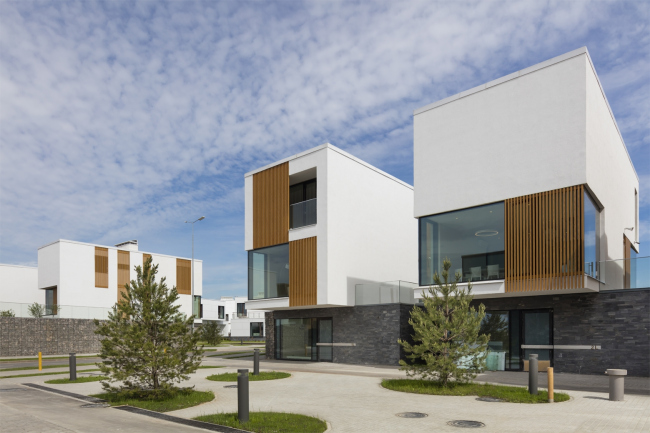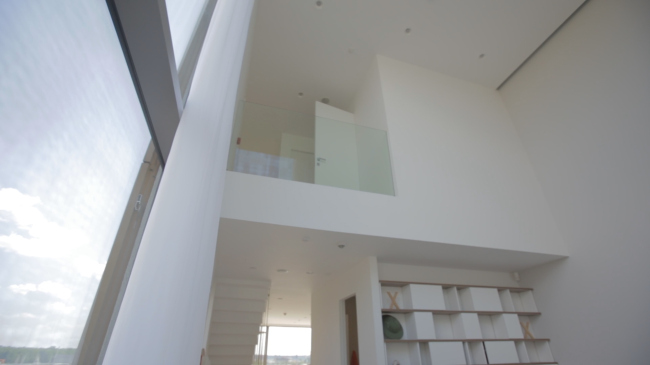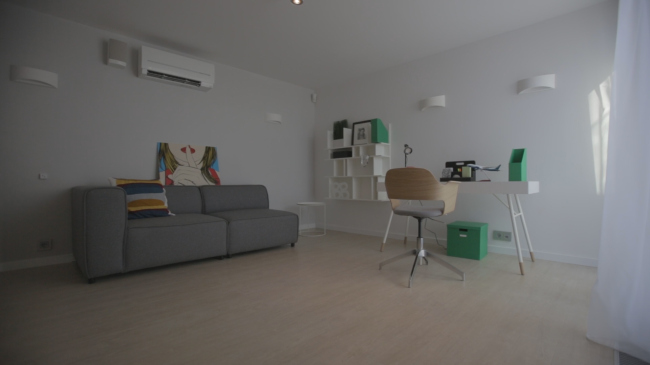|
Published on Archi.ru (https://archi.ru) |
|
| 25.08.2015 | |
|
Ecological Tetris |
|
|
Anna Starostina |
|
| Architect: | |
| Yuliy Borisov | |
| Studio: | |
| UNK | |
|
The construction of three residential districts in “Technopark” District D2 in Skolkovo innovation center is coming to an end. One of them – the tenth one – is being constructed according to the draft of UNK project that won an open tender in 2012. "Skolkovo. Technopark" Innovation Center. Residential area ¹10 © UNK projectThree years ago the draft of UNK project became one of ten winners of the open tender for residential housing of District D2 in “Technopark” in the innovation center “Skolkovo”. Today the buildings are almost done. The assignment given to the architects contained two it would seem mutually exclusive directives: on the one hand, they had to use the selected lot most efficiently and provide for high construction density; on the other – use large glazed areas, and in general – reach maximal permeability of the inner space. An unexpected approach to spatial arrangement helped to achieve sufficient privacy and – at the same time – save the integrity of the whole residential micro district. It nominally entitled “the Tetris Principle”. The computer game that appeared in mid 80s was incredibly popular then and became a kind of symbol of scientific and technological progress of the country. Curiously, today it helps to create media for new ideas and developments – even though very relatively. It is even more interesting, that the collegues of UNK project working on neighboring 9th and 11th sites – “BRT RUS” bureau and Agence d`Architecture A. Bechu – also remembered this nearly forgotten game in their designs. All the three districts are special, but conceptually and ideologically close. NoneThe micro district 10 is intended for construction of townhouses for in total 204 people. The center of the round lot divided by a street in two unequal parts is the place where the whole infrastructure is concentrated: a shop, a security station, public transport stop and a public center with a playground. In the felicitous words of the Chief Architect and founder of UNK project Yuliy Borisov: they have “managed to use the land twice”. The artificial drop of the relief allowed clear division public and private functions. The drive aisles are located on the ground level, and green terraces screened from view are situated on the upper one. Such arrangement of the micro district is the safest one and simultaneously allows a high level of interaction inside small groups of the neighboring ten houses. “Usually, residents of townhouses only know their neighbors on the right and left. Such place is extremely boring to live in. There can be no talk of a stimulating environment and exchange of ideas. For us it was really important to build up an actual alliance of creative, thinking people” – says Yuliy Borisov. Simple and clear cubic volumes of the buildings do remind neatly placed “Tetris blocks” of different shapes. Four types of planning have been developed within the layout of houses: for family couples, for parents with one or two children and for co-residence with elderly parents. The total area of each such unit varies from 2045 ft2 to 2346 ft2. Every ground floor is allocated for a parking lot and a study, and the main living quarters take up the overhanging first and second floors. At that, the two less dense plan types have obtained a double-height central area. And finally, every house has its own open terrace of 376-419ft2. This is the planning system that allowed to make floor-to-ceiling glazing 20 feet long and avoid the unpleasant “window to window” effect. And still in some places the glass is protected by metal grate masked in form a tree. They do not hinder the image inside the residential zone and serve as additional screening from view. Besides, the grates help to regulate the sunlight and protect the rooms from overheating and also, from the authors’ perspective, make the place more psychologically comfortable. "Skolkovo. Technopark" Innovation Center. Residential area ¹10 © UNK project"Skolkovo. Technopark" Innovation Center. Residential area ¹10. Master plan © UNK project"Skolkovo. Technopark" Innovation Center. Residential area ¹10 © UNK projectThe authors have chosen simple, reliable, eco-friendly and mainly recyclable materials: concrete, plaster, glass, metal, stone, ecological laminate panels imitating the texture of wood. The architects have renounced the idea of using natural wood counting on durability, simplicity and economy. At that, they have developed a single logic of material application: the bottom parts are coated either with slate (residential rooms) or granite gabions (bearing structures) – heavy and emphasizing closeness to earth through materials. The next level can be called “man-made” and it is defined by panels imitating wood and plastered surfaces of concrete walls. And the panoramic windows reflecting the clouds symbolize the top “sky level”. But the proportions of colors and textures of the facades is constantly changing providing for stylistic unity of the settlement on the one hand, and on the other – lending the necessary variety to the project. “We have managed to create quite expressive and emotional architecture that looks “expensive”. At the same time, we are using standard construction technologies and working with simple and comprehensive cubical forms. Thanks to this, the construction is rather low priced and quick” – says Yuliy Borisov. "Skolkovo. Technopark" Innovation Center. Residential area ¹10 © UNK project"Skolkovo. Technopark" Innovation Center. Residential area ¹10 © UNK projectStrange as it may seem, the term “typical” is very suitable for many solutions applied in the whole innovation center Skolkovo and the 10th micro district in particular. The architects had to unify the environment that they created, and on all levels: starting from city-planning solutions up to the interiors of different townhouses. The lack of unique, individualized solutions together with the use of BIM planning technology (it was a pilot draft of UNK project made in this technology) was exactly what helped to remain within a rather modest budget and cut back the length of construction without compromising on quality. But “unified” by no means equals “commonplace” or “average”. Such environment could never become a real “home” for people thinking outside the box. As a matter of fact, the irregularity of the task consisted in successful search of the thin line between “typological” and “individual”. Indeed, all the micro districts under construction possess their own distinctive architectural pattern, but they are very close ideologically. Then the facades of different volume and finishing solutions appear inside of the micro district forming a single creative atmosphere. The planning of the cottages is also typical on the one hand, and fulfills the individual requirements of the lodgers on the other. As for the interior design, the architects of UNK project have even developed a special brand book for the whole innovation center Skolkovo, thus giving the future lodgers the right to easily adjust the interior to themselves by, for example, changing the decorative finish of the walls. “In a way it reminds setting an interface of your PC: there is one operational system, but you can choose you own desktop image, set a screensaver or change the color scheme” – says Yuliy Borisov describing the idea. "Skolkovo. Technopark" Innovation Center. Residential area ¹10 © UNK project"Skolkovo. Technopark" Innovation Center. Residential area ¹10 © UNK project"Skolkovo. Technopark" Innovation Center. Residential area ¹10 © UNK projectIt is obvious that the principles of sustainable “green” construction must become the foundation of all the components of the large project of the innovation center. It is possibly the first time that they have been applied so fully and in such variety of ways. After the construction is completed the micro district will aspire to a prestige ecological certificate LEED. First of all, all the soil taken from the place of groundwork and communication lines was reused for creating artificial relief. Secondly, all the buildings are very energy-efficient: loss of heat has been minimized, for example, the glass is covered with a special protecting spray; LEDs, motion sensors and a lighting control system are actively made use of and there are also water saving bathroom fitments. Rain water and the so-called “grey water” is collected, treated and reused. The authors provide for large green areas, including drained green parking lots. And finally, every house is provided with an opportunity of installing solar panels. For now the architects consider this technology not as efficient in the Russian context, but they are hoping that within the next five years the situation will change and then one would only have to install the panels and connect to the integrated system. The main contractor of the three simultaneous district constructions (9, 10, 11) is RD Construction company. “Skolkovo” makes “green” construction fashionable in Russia. And for our company that specializes in complex, highly technological construction it is a significant and for sure principal project for today – notices Oleg Zhukov, the general director of RD Construction. – I would like to underline the fact that LEED standard imposes high requirements not only to the materials, but to the quality of work and the qualification of the employees. Today 60 of our top-qualified engineers are working in “Skolkovo”, and the total number of RD Construction employees engaged in the project exceeds 1000”. The construction on site 10 is planned to be finished in the last quarter of 2015. For now RD Construction has in only 21 day built and decorated a demonstration townhouse. Its inauguration was visited by the Prime Minister of Russia – Dmitriy Medvedev. “The work on this project gave us an absolutely unique opportunity to look several decades ahead with the help of architectural instruments and comprehend the very meaning of the “future architecture” – says Yuliy Borisov. “I am sure that the notorious innovativeness is really not the highly modern technologies – although you cannot do without them – and not the fanciful futuristic forms. It is rejection of the old stereotypes of planning. People’s lifestyle is changing and we must find a suitable environment, express these changes in spatial and plastic solutions. It was exciting to try to create a city for people that are much more advanced than we are. I really hope that we managed to do it.” "Skolkovo. Technopark" Innovation Center. Residential area ¹10 © UNK project"Skolkovo. Technopark" Innovation Center. Residential area ¹10 © UNK project"Skolkovo. Technopark" Innovation Center. Residential area ¹10 © UNK project"Skolkovo. Technopark" Innovation Center. Residential area ¹10 © UNK project"Skolkovo. Technopark" Innovation Center. Residential area ¹10 © UNK project |
|














